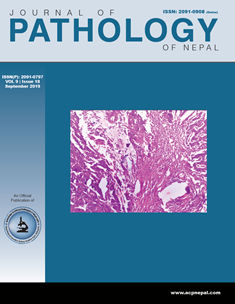Role of Pap smear in the screening of cervical cancer: A hospital based study
DOI:
https://doi.org/10.3126/jpn.v9i2.24876Keywords:
Carcinoma, Cervix, Cervical screening, Pap smearAbstract
Background: Incidence of cervical cancer has decreased in the developed world due to use of Pap smear as a screening tool. It has been proven as a sensitive screening tool for cervical cancer but its coverage is very low in Nepal. The objective of this study is to find out the incidence of cervical epithelial cell abnormality, its demographic distribution and common presenting symptoms.
Materials and Methods: This retrospective comparative study was conducted in Nobel Medical College and Teaching Hospital, Biratnagar, Nepal. A total of 950 patients attending gynecological department with various symptoms were enrolled. Only 902 patients were included in the study after excluding inadequate samples.
Results: The mean age of patient was 37.94 ± 12.74 years with minimum age of 18 and maximum age of 79 years. The mean age of patients with epithelial abnormality was 47.88 ± 8.87 years. The highest number of Atypical squamous cells of undetermined significance was observed between 51-60 years (1.1%) whereas Low and High grade squamous intraepithelial lesion were mostly observed between 41-50 years (3.2% and 0.4% respectively). The most common symptom was vaginal discharge (41.6%) followed by pain abdomen (23.1%).
Conclusions: Pap smear is a cost effective, sensitive and simple screening test for cervical premalignant and malignant lesions.
Downloads
Downloads
Published
How to Cite
Issue
Section
License
This license enables reusers to distribute, remix, adapt, and build upon the material in any medium or format, so long as attribution is given to the creator. The license allows for commercial use.




